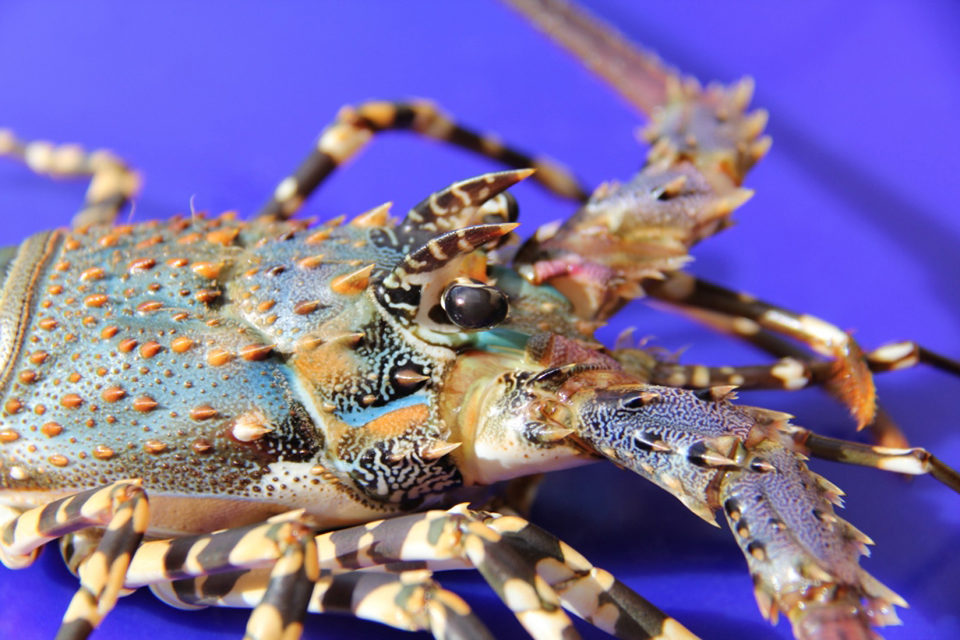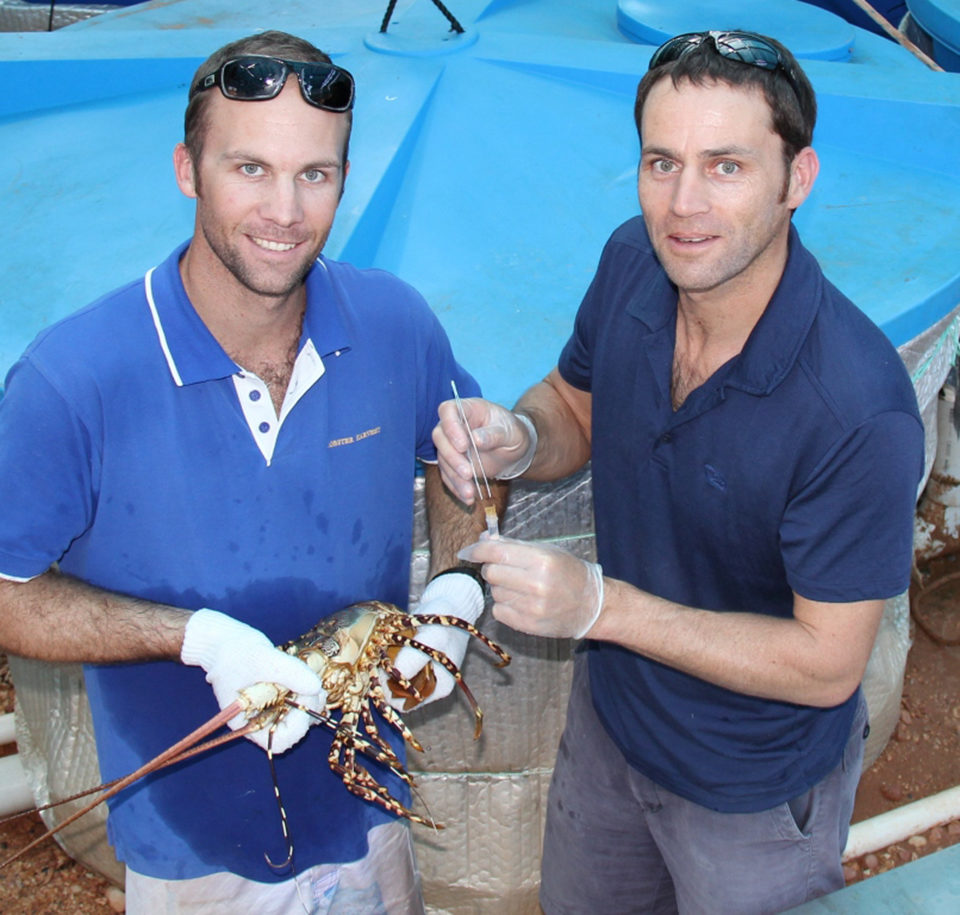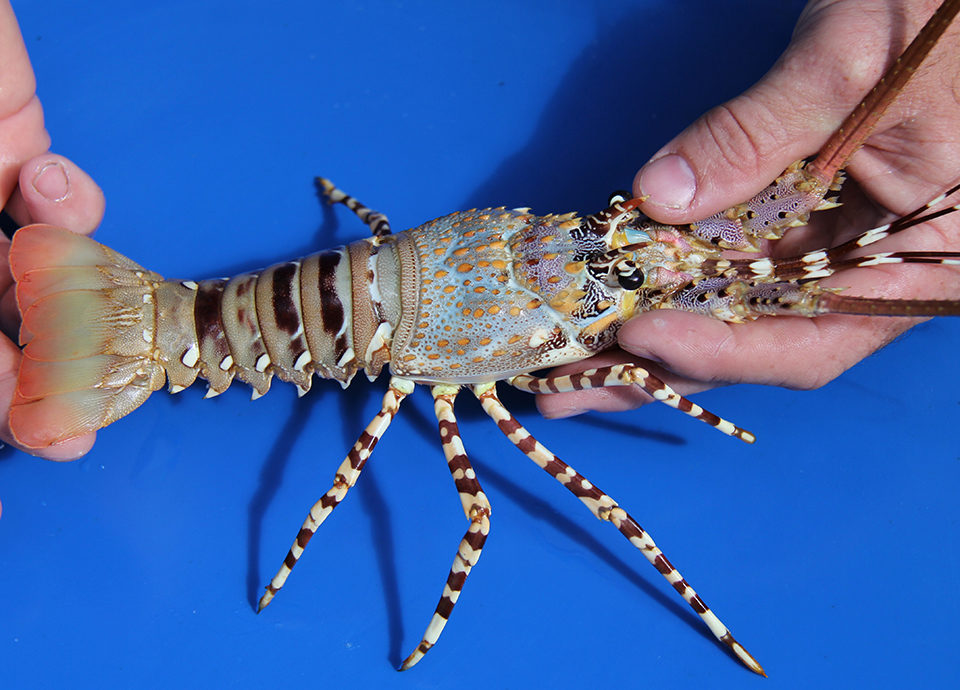Meeting growing demand for premium product

The spiny lobster is regarded worldwide as a premium seafood, with China the main export market for most product in recent years. This is especially the case for the tropical species Panulirus ornatus, for which the demand far exceeds supply.
The overwhelming market preference is for live animals in good condition on arrival and during holding. P. ornatus are particularly well suited to transport and holding. They are also prized for their 0.8 kg or larger size, beautiful colors and firm, pearly flesh that is perfect for serving raw as sashimi. In many Asian countries, serving P. ornatus is an honor for guests as well as a sign of the hosts’ success and high status.
P. ornatus is the most valuable of all tropical spiny lobster species. In the past, most product was sourced from wild fisheries in southeastern Asian and the Torres Strait. Farmed lobsters, which can be grown from the puerulus stage at less than 1 g to 1 kg in 18 months, now constitute a large proportion of the supply to this market.
Wild postlarvae
In an article by Bruce Phillips and Ravi Fotedar in the January/February 2010 Global Aquaculture Advocate, the authors outlined how Vietnam provided up to 4,000 metric tons (MT) per year of farmed product to meet the growing demand from China. This farming enterprise is based on the capture and growout of wild postlarvae (pueruli and juveniles).
Since a high point in 2007-2008, a combination of reduced catches of postlarvae and diseases has led to a fall in farm production from Vietnam. From 2007 to 2010, the numbers of seedstock P. ornatus caught in Vietnam slipped from 2.1 million to 0.9 million. The resulting decline in production cost the industry millions of dollars.
Other neighboring countries are now taking up the aquaculture of tropical spiny lobsters based on the capture of postlarvae. However, both the lack of sustainability in terms of fisheries management and the inconsistency in catch of postlarvae limit the size and growth of the industry.
An Australian company, Lobster Harvest Ltd., is set to shift the lobster-farming paradigm away from the capture of wild seedstock to more reliable and sustainable hatchery production of spiny lobsters.

P. ornatus propagation

culture to further advance.
In most aquaculture enterprises, the demand for seedstock is met by propagation from hatchery production. This is certainly the case for shrimp, finfish and mollusks. Unlike these species, though, where the larval phase lasts only a few days or weeks, larval development in spiny lobsters takes many months. During this period, the phyllosoma larvae undergo more than 20 instars before metamorphosis to the postlarval puerulus stage.
Fortunately, P. ornatus is one of the most rapidly developing spiny lobsters, with a larval phase of “only” five months rather than the 10 to 12 months for some other species. For this reason, in addition to its rapid growth rates from postlarvae to market size and favored market characteristics, P. ornatus was chosen by Lobster Harvest as the species for potential hatchery propagation.
Due to the long and complex larval phase, hatchery rearing of spiny lobsters has proven difficult. M.G. Kailis began investing in P. ornatus propagation over 10 years ago by funding research carried out by the Queensland Department of Primary Industries in Cairns, Australia. M.G. Kailis produced the world’s first hatchery-reared P. ornatus postlarvae in 2006 at its facility in Exmouth, Western Australia. More postlarvae were produced in subsequent years by Lobster Harvest, the company M.G. Kailis set up for the purpose of commercializing lobster propagation.
Larval nutrition
The successful culture of larvae depends on optimizing their nutrition, and this has typically consisted of feeding fresh diets of artemia during early larval development, followed by supplementary chopped mussel gonad for older larvae. For both these fresh items, there may be problems of inconsistency in quality, such as reduced nutritive value or increased loads of infectious microorganisms, which reduce success in the hatchery.
Although a semi-moist or encapsulated formulated diet consisting of commercial ingredients is a worthy ideal for which to strive as a replacement for live diets during the larval phase, there has historically been little success. However, Lobster Harvest developed a range of feeds for mid- to late-stage phyllosoma that improved the rate of metamorphosis, the traditional bottleneck of spiny lobster aquaculture (Table 1).
Barnard, Mean survival rates of spiny lobster larvae, Table 1
| Control | Diet A | Diet B | Diet C |
|---|
Control | Diet A | Diet B | Diet C | |
|---|---|---|---|---|
| Successful metamorphosis to puerulus | 1.1% | 11.9% | 12.2% | 12.7% |
| Juveniles produced | 0.3% | 5.5% | 5.6% | 8.1% |
Three alternative diets (A, B, C) were compared to the control diet of chopped mussels. There was a marked improvement in the successful metamorphosis to puerulus with all three alternatives. Further, diet C produced the highest rate of successful molting from puerulus to the juvenile stage.
These findings propelled the potential hatchery production of seedstock into the commercial-ready state. With 5 to 8 percent mean survival from egg hatch to the juvenile stage, this diet technology is now being scaled up from the small 15-L experimental tanks to an industrial level.

Larval culture systems
The culture systems for phyllosoma rearing have received considerable atten-tion and historically vary markedly in size. The important considerations for larval culture are that contact be minimized between animals and for animals with their culture vessel surfaces, while ensuring good feed accessibility, optimum hygiene and high-quality water.
Phyllosoma have been cultured in vessels from 15-L bowls to industrial-scale tanks of 250 L in 2010 and more recently in 1,000-L tanks. The authors compared production-scale culture of larvae in 40-L New Zealand upwellers, standard 220-L conical tanks originally used for artemia production, and newly designed 250-L larviculture tanks. All animals were fed a diet consisting of a combination of enriched artemia, chopped mussels and the new larval diets.
There were large differences in larval performance between designs of culture tanks (Table 2). The highest overall survival through metamorphosis to puerulus, 8.5 percent, was for the new 250-L conical tanks, with survivals ranging 6.5 to 10.2 percent. Mean survival to the juvenile stage was 3.5 percent, ranging from 1.9 to 4.4 percent. The other tanks produced considerably fewer pueruli (0.4 to 3.3 percent) and juveniles (0.3 to 0.7 percent).
Barnard, Performance of spiny lobster phyllosoma larvae, Table 2
| 40-L Upweller | 220-L Conical Tank | New 250-L Conical Tank |
|---|
40-L Upweller | 220-L Conical Tank | New 250-L Conical Tank | |
|---|---|---|---|
| Mean survival to puerulus | 3.3% | 0.4% | 8.5% |
| Mean survival to juvenile | 0.7% | 0.3% | 3.5% |
The superior performance of the new tank design has provided confidence to scale up operations to the 1,000-L larviculture tanks to achieve higher efficiency in hatchery rearing. Multiple units are being built and installed for pilot-scale commercial production of juvenile seedstock from the Exmouth facility.
Breeding, genetic selection
The F1 juveniles produced from 2006 to 2008 were grown to sexual maturity and produced three F2 larval cohorts that were successfully cultured to the juvenile stage in 2010, with more F2 cohorts cultured in 2011. The production of F2 larvae was the first true closure of the life cycle of P. ornatus – and the first for any spiny lobster species – providing the opportunity for selective breeding and genetic improvement. It is estimated that production traits in crustaceans can typically be improved by up to 15 percent per generation through selective breeding.
Perspectives
The unique hatchery technology of Lobster Harvest is approaching the commercialization phase. Importantly, lobster survival to the juvenile phase is over 5 percent, providing a hatchery-rearing efficiency equivalent to other high-value cultured species.
Lobster Harvest expects to enter commercial hatchery production by 2013. This new hatchery production could be readily incorporated to improve the existing cage culture of tropical spiny lobsters, which is located mainly in Vietnam and elsewhere in Southeast Asia. Since the industry is currently solely reliant on the capture of wild seedstock for growout, a central hatchery could offer the stability needed for further investment and expansion of the entire sector.
The company recently exported hatchery-produced F1 and F2 P. ornatus juveniles, along with more than 10,000 hatchery-produced slipper lobster seedstock, to a growout test site in Sabah, Malaysia, where they are being cultured under typical farming conditions in ocean cages. In addition, Lobster Harvest is testing a pelleted growout diet for tropical spiny lobsters developed over the past four years. Laboratory trials in Perth, Western Australia, have demonstrated superior survival and pigmentation in lobsters given the formulated feed compared to fresh diets.
(Editor’s Note: This article was originally published in the September/October 2011 print edition of the Global Aquaculture Advocate.)
Authors
-
Roger M. Barnard
Lobster Harvest Ltd.
50 Mews Road
Fremantle, Western Australia 6160 Australia -
Matthew D. Johnston, Ph.D.
Lobster Harvest Ltd.
50 Mews Road
Fremantle, Western Australia 6160 Australia -
Bruce Phillips, Ph.D.
Curtin University
School of Agriculture and Environment
Muresk Campus
Perth, Western Australia -
Arthur J. Ritar, Ph.D.
Lucky Red Lobster Pty. Ltd.
Kingston, Tasmania, Australia
Tagged With
Related Posts

Innovation & Investment
Aquaculture in Canada: status, perspectives
Canada exports farmed seafood products to more than 22 countries and is the main seafood supplier to the U.S. market. Finfish, primarily salmon, production is strong and shellfish production is growing, but diversification will be imperative to maintain competitiveness.

Health & Welfare
Lobster farming in Indonesia
A multinational project in Lombok, Indonesia, is focused on the identification and monitoring of improved seed collection and grow-out production methods for spiny lobsters.

Innovation & Investment
Pilot lobster production facility in Iceland used geothermal groundwater
Following earlier work in southwestern Norway that achieved semi-commercial production of European lobsters, a project has received grant support to develop commercialized land-based recirculating aquaculture of lobsters utilizing geothermal water sources in Iceland.

Innovation & Investment
UK lobster-farming project breaks new ground
A project to grow lobsters in the open sea is giving researchers hope that the technology behind stock enhancement could be improved and that lobster farming could provide new prospects for diversification and employment.


